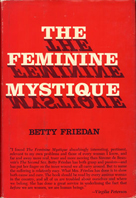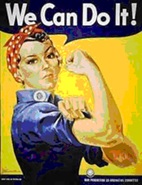THE BEGINNINGS
Esther Peterson, the director of the Women's Bureau of the Department of Labor in 1961, considered it the government's responsibility to take an active role in addressing discrimination against women. With her encouragement, President Kennedy established the first presidential Commission on the Status of Women, naming Eleanor Roosevelt as its chair. The report issued by that commission in 1963 documented discrimination against women in virtually every area of American life: employment discrimination, unequal pay, legal inequality, and insufficient support services for working women.
 In 1963, Betty Friedan published The Feminine Mystique, a critique of middle-class living patterns which challenged the notion that women could find fulfillment only as wives and mothers. Friedan encouraged her readers to seek new roles and responsibilities, to find their own personal and professional identities, rather than letting them be defined by a male-dominated society. In 1963, Betty Friedan published The Feminine Mystique, a critique of middle-class living patterns which challenged the notion that women could find fulfillment only as wives and mothers. Friedan encouraged her readers to seek new roles and responsibilities, to find their own personal and professional identities, rather than letting them be defined by a male-dominated society.
Two wings of the feminist movement
During the debate on the 1964 Civil Rights Act, opponents hoped to overthrow the entire measure by proposing an amendment to prohibit discrimination on the basis of gender, race, religion, and national origin. First the amendment, then the bill itself, passed and the Equal Employment Opportunity Commission (EEOC) was established to investigate discrimination complaints. Within the commission's first five years, it received 50,000 sex discrimination complaints, but rarely pursued those.
 When the EEOC ignored gender-based charges, 28 professional women, including Friedan, established the National Organization for Women (NOW) "to take action to bring American women into full participation in the mainstream of American society now." Soon an array of other mass-membership organizations followed, addressing the needs of specific groups of women, including Blacks, Latinas, Asians-Americans, lesbians, welfare recipients, business owners, aspiring politicians, and tradeswomen and professional women of every sort. When the EEOC ignored gender-based charges, 28 professional women, including Friedan, established the National Organization for Women (NOW) "to take action to bring American women into full participation in the mainstream of American society now." Soon an array of other mass-membership organizations followed, addressing the needs of specific groups of women, including Blacks, Latinas, Asians-Americans, lesbians, welfare recipients, business owners, aspiring politicians, and tradeswomen and professional women of every sort.
In the meantime, another wing of feminism developed. Thousands of young women on college campuses were playing active roles within the anti-war and civil rights movement. Soon, these young women began forming their own "women's liberation" organizations to address their role and status within these progressive movements and within society at large. Small "consciousness-raising" groups were formed, rapidly expanding in number. In these groups, women met to discuss the injustice of "sexism"; to struggle for "women's liberation"; and to start feminist projects, such as health collectives or rape crisis centers.
While NOW focused on legal change, women's liberation urged revolutionary transformation. The two sections sometimes joined forces, as in The Women's Strike for Equality in August 1970. With parades and marches, women celebrated the 50th anniversary of suffrage movement and pressed for new causes—equal employment opportunity, an equal rights amendment, and more liberal state abortion laws.
|

